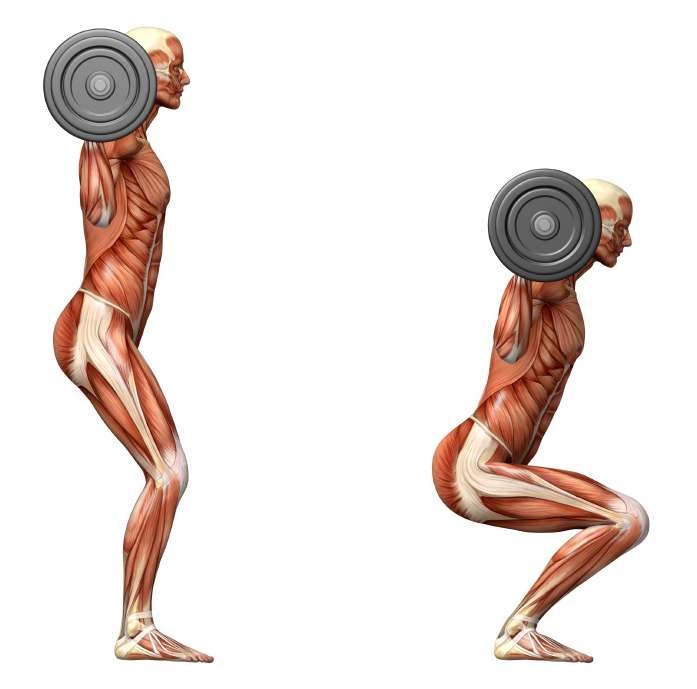 Do you ever pay attention to if you’re inhaling or exhaling to get up and down? Chances are you’ve probably never really thought about your breath during these simple daily life activities, but the patterns for breathing and exercise that we use, should be helping to reinforce healthy movement habits.
Do you ever pay attention to if you’re inhaling or exhaling to get up and down? Chances are you’ve probably never really thought about your breath during these simple daily life activities, but the patterns for breathing and exercise that we use, should be helping to reinforce healthy movement habits.
Squat exercises aren’t something we only do in the weight room. There are lots of activities that require a squat motion – can you think of exercises, activities, sports, or things you do during your daily life multiple times a day that involve squatting? And then answer this… Do you breathe in our out as you bend your knees for a squat? Which is best for your body? Does it matter?
For me weight room Squat exercise breathing, and Pilates footwork breathing are completely opposite! And there’s a very good reason why. Gravity and Resistance!
I recently received an email with a question about which breathing pattern was correct for Pilates Footwork on the Reformer. Are you supposed to inhale as you press out to straighten the legs, and exhale as you bend the knees? Or exhale to press out and inhale to bend the knees?
I’ve written whole article to explain my thoughts and reasoning behind the three different breathing patterns I teach for Pilates Footwork, so I’m not going to bore you and completely repeat myself here… But if you haven’t seen it yet, and want details to fine-tune breathing and exercise for your Pilates Footwork, check out the article.
Since I’m dialed in to pay attention to better breathing habits, I’ve been thinking a lot about the crossover from breathing and Pilates, to other activities, (Breathing and Squat exercises, for example in the weight room.) But even sitting down and getting up out of a chair, (or up and down off the toilet!) how you’re breathing can make a BIG difference for ease of movement.
Breathing and Pilates Footwork
When doing Pilates I prefer inhale to straighten the legs and exhale to bend for Footwork on the Reformer. (This by all intents and purposes looks like a squat lying on your back.) Granted my clients have to be strong enough to maintain good body alignment for this breath pattern. If they can’t we change it until they get stronger. Inhaling to extend helps to lengthen the natural curves of the spine, while you’re opening the hips, lengthening the legs, and working against the spring. You’re learning how to do horizontally what’s needed to fight against gravity when your body is vertical!
Breathing and Squat Exercises
But for a Squat in the weight room, chances are you’ve got a bar across your back – which is extra weight compressing down on the spine. And to bend and squat you’re going down with gravity, down is the relatively easy part! Your breath pattern on a standing squat has to be different for exercise safety.
It’s going down for a squat with control and good body alignment that’s important to avoid injury. So it make sense to me that you INHALE to squat down to help keep the back in a well-supported “open joint” “maintaining the natural curves of the spine” position while flexing at the hips, knees, and ankles, and Exhale to push from the Glutes, and pull in with the Abs to support lifting the weight UP while straightening the legs.
I do believe that just like doing Pilates, if you’ve really got good form, it shouldn’t matter whether you’re on an inhale or exhale to move. However, if you need better body support, how you’re breathing, and when you inhale and exhale can make a big difference in your ability to maintain good form, proper support, and execute free and easy motion. In my mind exhaling to squat down, and inhaling to come up, is a recipe for disaster in the weight room for a lesser-experienced, “new” to squatting participant. Anyone who is serious about minimizing the risk of aggravating or creating a lower back injury should inhale to bend (squat) and exhale to extend (stand back up.)
How do you figure out what’s safest and best breathing pattern for you?
- Consult with your Pilates teacher or personal trainer to find out what they think is best. Then have them help you analyze the exercises you do in Pilates, Yoga, the Weight room, or any other sports and activities to determine if your current breathing habits are helping or hurting your form, and function for better fitness.
- Play with your breath patterns and see what’s easiest for you. (Easiest might not necessarily be “Best.” And the best breath pattern for you might change as you get stronger and more experienced.)
Keep in mind – for Posterio-Lateral “Pilates-style” Breathing done well, “Inhaling INCREASES the Natural Curves of the Spine.”
Inhaling especially for a squat exercise and Pilates footwork shouldn’t change the curves of your spine! A spine out of alignment during a squat can lead to instant injury for your knees or back! And Posterio-Lateral breathing isn’t just for Pilates class. It’s the best way to breath for all your physical activities. Pilates is only helping you to reinforce this great posterior-lateral breathing habit!
Pilates footwork, and squat exercises are excellent for your hips, and legs. Use the increase in length with your good breathing habits to help improve posture and help develop the right muscle support to maintain length and strength. More length with better breathing = better body support, less back pain, a stronger core, and good hip mechanics to squat down and stand back up!
Have fun focusing on your breathing to develop healthy movement habits for better footwork, a happy back, to enjoy healthy hips and knees for squatting with ease!


0 Comments